TEN YEARS AGO TODAY! THE CRAZY, WHACKED-OUT WORLD OF 2015 FORKS
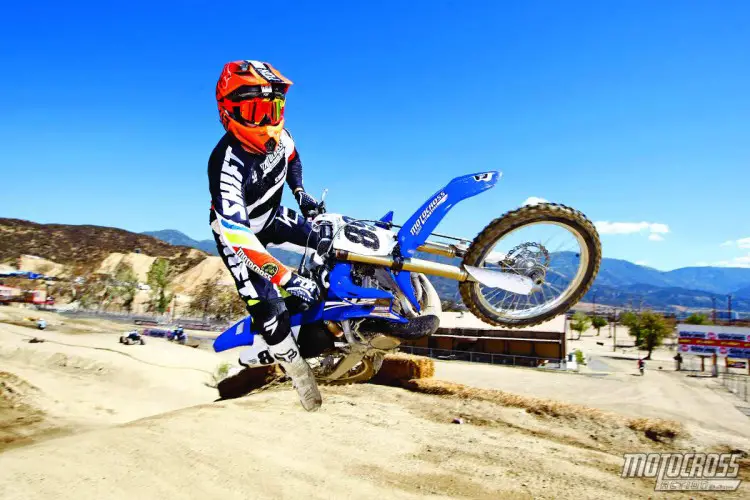
Believe it or not, were are six different types of forks available on the 2015 motocross bikes. The forks came from three different suppliers: Kayaba, Showa and WP. Half of the forks feature air springs, and only one fork design remains relatively unchanged from 2014—the highly rated Kayaba SSS forks found on Yamahas. The MXA wrecking crew wants you to know as much about the fork choices of 2015 as possible, so to that end, we provided a guide to 2015 motocross forks.
SHOWA SFF TAC PIGGYBACK:
AIR SPRUNG 3-CHAMBER SFF WITH PIGGYBACK BALANCE SPRING
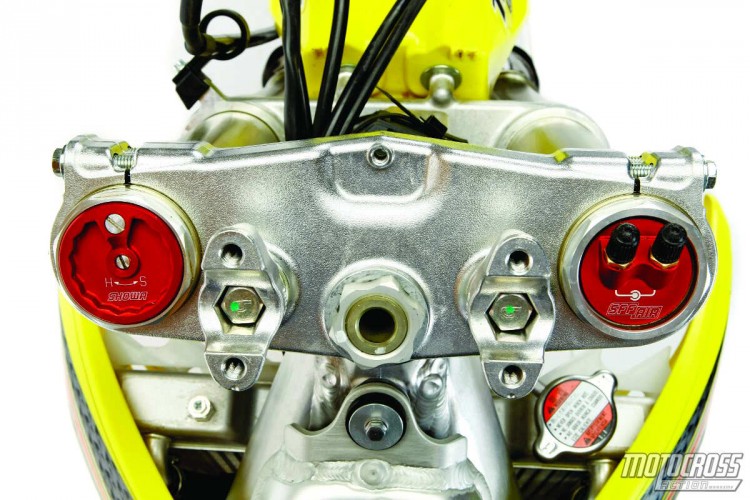
The acronym SFF stands for “Separate Function Fork,” which refers to the fact that the fork has a spring in one fork leg and damping in the other. The acronym TAC stands for “Triple Air Chamber,” meaning that the SFF TAC fork has three separate and unique air chambers. The “piggyback” reference is because the balance chamber is located in an extension sticking out behind the right fork lug. The piggyback designation is required because Showa makes an SFF TAC air fork that does not house the balance air pressure in a remote reservoir.
WHAT IT COMES ON
Kawasaki KX450F and Suzuki RM-Z450
TYPE
Oil-damped, triple air chamber forks
SPRING
Air pressure (in three chambers)
Chamber……………..KX………RM-Z
Inner chamber…….146 psi…174 psi
Outer chamber…….7.5 psi….0 psi
Balance chamber…130 psi…174 psi
FORK OIL HEIGHTS
Chamber……………..KX………RM-Z
Inner chamber……100cc…….100cc
Outer chamber…….300cc…..250cc
Balance chamber….10cc…….10cc
Damper leg………….340cc…..340cc
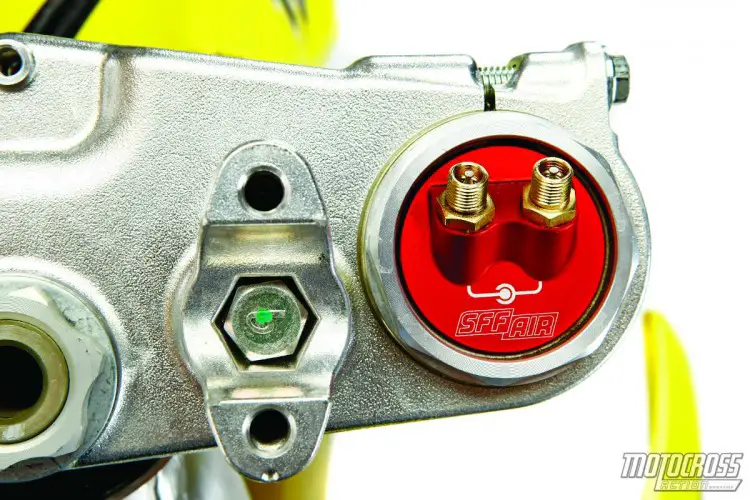
FORK TUBE DIAMETER
49mm
DAMPING CLICKER LOCATION
Compression: On top of left fork cap
Rebound: On bottom of left fork leg
STANDARD SETTINGS
KX450F Compression: 5 clicks out
KX450F Rebound: 13 clicks out
RM-Z450 Compression: 8 clicks out
RM-Z450 Rebound: 13 clicks out
TECHNICAL NOTES
(1) All damping is in the left fork leg. The right-side fork cap is held on with a snap ring. (2) Showa does not recommend changing oil heights on the air side of the fork, but in the left damper leg instead. (3) Kawasaki suggests 7.5 psi (actually it recommends 7.3 psi in the outer chamber, but the supplied pump will not read that setting). (4) Suzuki suggests 0 psi. Frankly, we know factory riders who run as much as 20 psi in the outer chamber, and we have raced with 0 psi in the KX450F with no major issues. (5) If you blow a fork seal, the fork will not go flat because the main air pressure is held in the inner chamber, not the outer chamber.
SHOWA SFF TAC INTERNAL:
AIR SPRUNG 3-CHAMBER SFF WITH INTERNAL BALANCE SPRING
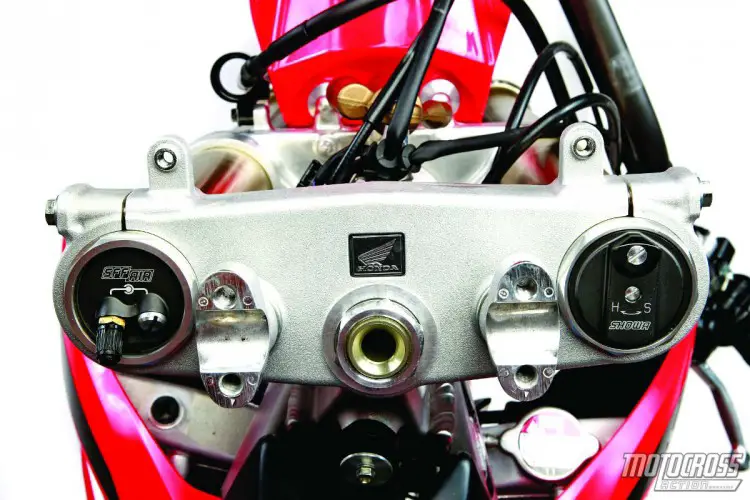
The SFF TAC internal fork differs from the SFF TAC Piggyback forks in that the air springs are housed in the left fork leg instead of the right leg, which puts the damping on the right side. Additionally, the SFF TAC internal fork does not have the piggyback balance chamber on the bottom of the left fork leg because it would hit the front brake (Kawasaki and Suzuki put the air pressure on the right leg to keep it away from brake rotor heat). Instead, the SFF TAC internal fork has its balance spring (also called a negative spring) built into the internals of the fork (with a Schrader valve under the fork leg where the rebound clicker would normally be found).
WHAT IT COMES ON
Honda CRF250
TYPE
Oil-damped, air sprung, triple air chamber
SPRING
Air pressure (divided into three chambers)
Chamber: Honda CRF250
Inner chamber: 174 psi
Outer chamber: 0 psi
Balance chamber: 163 psi
FORK OIL HEIGHTS
Chamber: Honda CRF250
Inner chamber: 87cc
Outer chamber: 310cc
Balance chamber: 0cc
Damper leg: 350cc
FORK TUBE DIAMETER
49mm
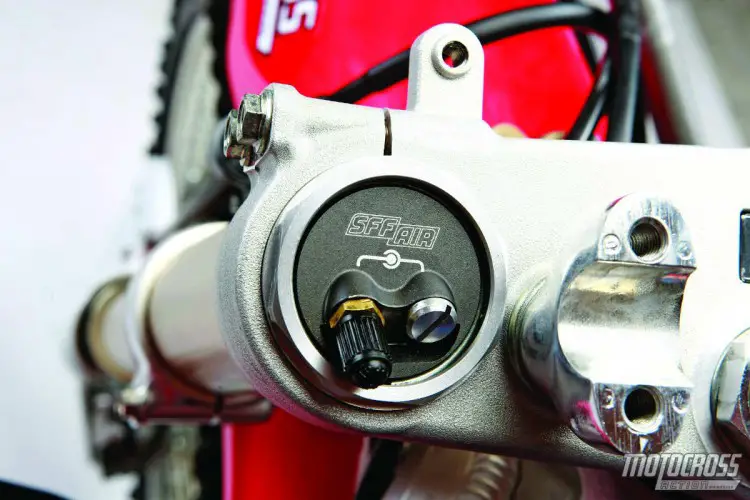
DAMPING CLICKER LOCATION
Compression: On top of right fork cap
Rebound: On bottom of right fork leg
STANDARD SETTINGS
CRF250 Compression: 5 clicks out
CRF250 Rebound: 12 clicks out
TECHNICAL NOTES
(1) Air pressure for the balance spring is under the left fork lug. There is no oil inside the balance chamber on the CRF250 fork. (2) Air pressure for the inner chamber is on top of the left fork cap. There is no Schrader valve on the fork cap for the outer chamber—just a bleed screw. But, a Schrader valve could be threaded into the outer chamber bleed hole. (3) The left-side fork cap is held on with a snap ring. (4) All damping is in the right fork leg. (5) Showa does not recommend changing oil heights on the air side of the fork but in the left damper leg instead. (6) If you blow a fork seal, the fork will not go flat because the main air pressure is held in the inner chamber, not the outer chamber.
SHOWA SFF COIL SPRING FORK:
NON-PNEUMATIC SINGLE FUNCTION FORK
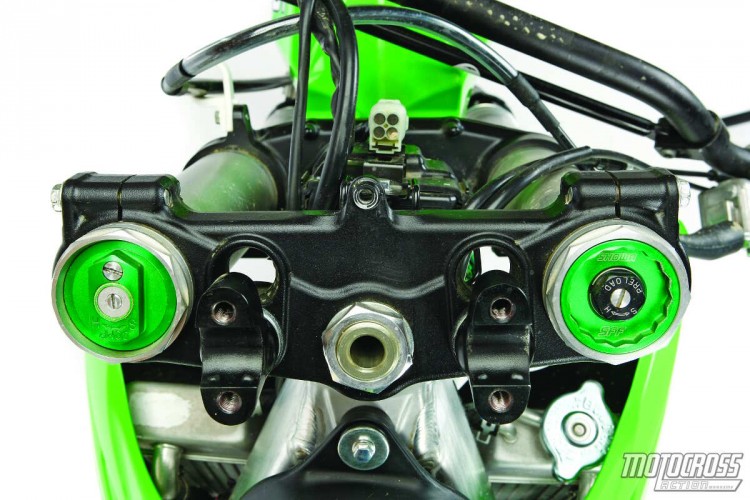
The SFF acronym stands for “Separate Function Fork,” which refers to the fact that it has its spring in one fork leg and damping in the other. Think of the SFF as an SSF (Single-Sided Fork), because that’s what it really is. Showa calls it a Single Function Fork because each fork leg has its own function—but that would more accurately make it a Double Function Fork (DFF). The major difference between the original Showa SFF fork and Showa SFF TAC fork is that the plain SFF fork uses a coil spring instead of air pressure. Additionally, the coil spring can have its preload adjusted via a clicker on top of the right fork cap.
WHAT IT COMES ON
Kawasaki KX250F and Suzuki RM-Z250
TYPE
Oil-damped, one coil spring
SPRING
KX250F spring rate: 0.97 kg/mm
RM-Z250 spring rate: 0.99 kg/mm
FORK OIL HEIGHTS
Side………..KX……..RM-Z
Left leg……320cc…340cc
Right leg…223cc….340cc
FORK TUBE DIAMETER
48mm
DAMPING CLICKER LOCATION
Compression: On top of the left fork cap
Rebound: On the bottom of the left fork leg
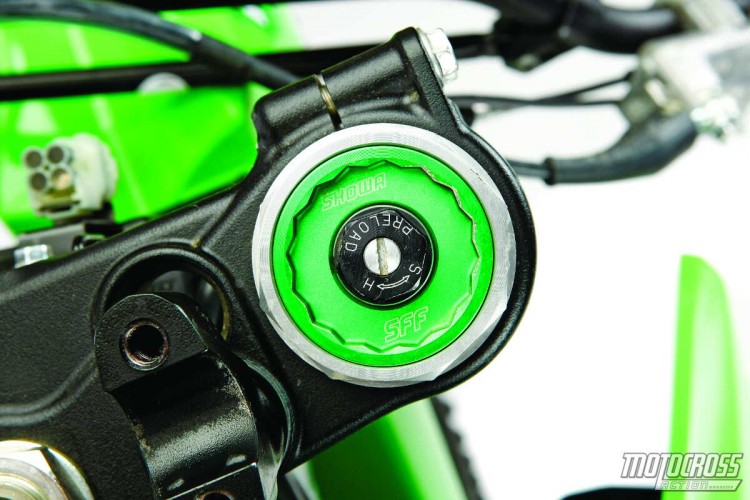
STANDARD SETTINGS
KX250F Compression: 9 clicks out
KX250F Rebound: 12 clicks out
KX250F Preload: 8 clicks in (from all the way out)
RM-Z250 Compression: 11 clicks out
RM-Z250 Rebound: 9 clicks out
KX250F Preload: 8 clicks in (from all the way out)
(1) All damping is in the left fork leg. (2) Changes to oil height make the most difference on the left fork leg (damping side), although you can add or remove oil from the right (coil spring side) leg. (3) Spring preload can be adjusted via the dial in the center of the right fork cap. Four clicks of the preload adjuster are equal to 1mm of preload. (4) There are air bleed screws on top of both fork caps. (5) If you blow a fork seal, there is no danger of a coil spring going flat.
WP 4CS COIL SPRING FORK:
FOUR-CHAMBER COIL-SPRING FORK
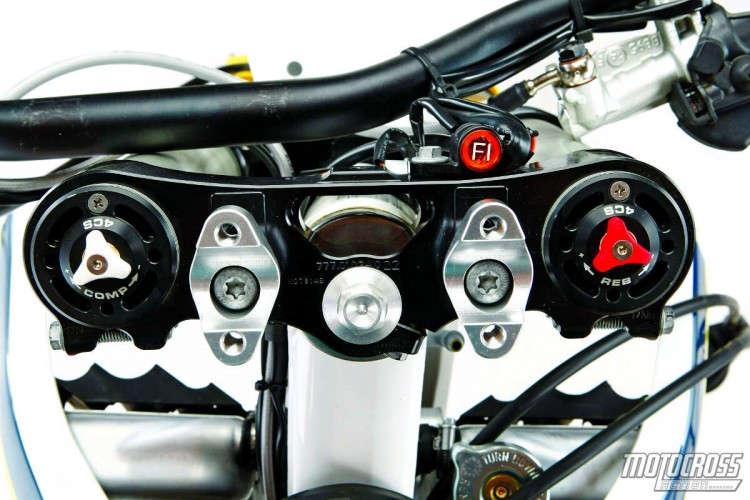
The WP 4CS fork is quite unique in its design and philosophy. For example, you can change the fork spring without taking the forks completely apart. Additionally, the oil height is set by the old-school method of measuring down from the top of the fork to the oil in millimeters. The Kayaba PSF-2 and WP 4CS share the concept of utilizing one fork leg for rebound damping and the other for compression while keeping both compression and rebound damping shims the same in both legs. What makes one leg dedicated to compression as opposed to rebound is the free-bleed design. 4CS stands for Four Chamber System, and it shares nothing in common with the previous WP bladder fork. Only American bikes will get 4CS forks. European bikes will get the WP bladder forks.
WHAT IT COMES ON
KTM 125SX 150SX, 250SX, 250SXF, 350SXF, 450SXF and all Husqvarna models
TYPE
Oil-damped, two coil springs, springs in both legs
SPRING
125/150SX spring rate: 0.44 Nm
250SX spring rate: 0.46 Nm
250SXF spring rate: 0.46 Nm
350SXF spring rate: 0.48 Nm
450SXF spring rate: 0.48 Nm
FORK OIL HEIGHT
Oil height: 100mm (from top of fork leg with springs out and fork collapsed)
FORK TUBE DIAMETER
48mm
DAMPING CLICKER LOCATION
Compression: On top of the left fork cap
Rebound: On top of the right fork leg
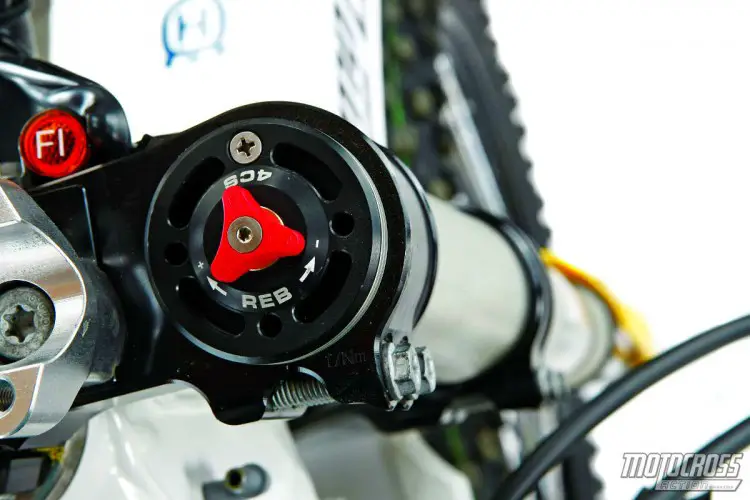
STANDARD SETTINGS
Compression: 15 clicks out
Rebound: 15 clicks out
TECHNICAL NOTES
(1) Rebound damping is in the right fork leg. (2) Compression damping is in the left fork leg. (3) The 4CS fork has a different front-axle offset from the 2014 WP bladder fork and uses a smaller 20mm front axle. (4) WP is the only fork company to put easy-to-use dials on the fork caps for compression and rebound as opposed to screwdriver slots. (5) If you blow a fork seal, there is no danger of a coil spring going flat.
KAYABA PSF-2 PNEUMATIC FORK:
SECOND GENERATION OF THE PSF
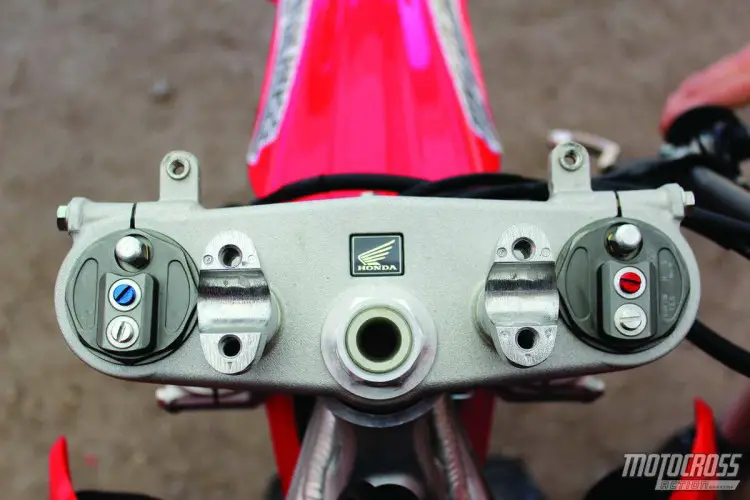
Honda and Kawasaki were the first bike manufacturers to switch to Kayaba PSF air forks. In 2015, Kawasaki has bolted on the Showa SFF TAC piggyback fork, while the Honda CRF450 will get a vastly updated version of the original PSF air fork. The all-new PSF-2 fork is still a single-chamber air fork, unlike its triple-chamber competition, and has air pressure in both legs. The biggest difference between last year’s PSF fork and the PSF-2 is that the Kayaba PSF-2 fork uses the left fork leg for compression damping and the right fork leg for rebound damping. As a bonus, there are three fittings on each fork cap: one is for air pressure, one is for high-speed compression or rebound, and the other is for low-speed.
WHAT IT COMES ON
Honda CRF450
TYPE
Oil-damped, air sprung with damping and air pressure in both fork legs
SPRING
Air pressure: 35 psi
FORK OIL HEIGHT
Oil height: 92mm
FORK TUBE DIAMETER
48mm
DAMPING CLICKER LOCATION
Hi-speed compression: On top of left fork cap
Lo-speed compression: On top of left fork cap
Hi-speed rebound: On top of right fork cap
Lo-speed rebound: On top of right fork cap
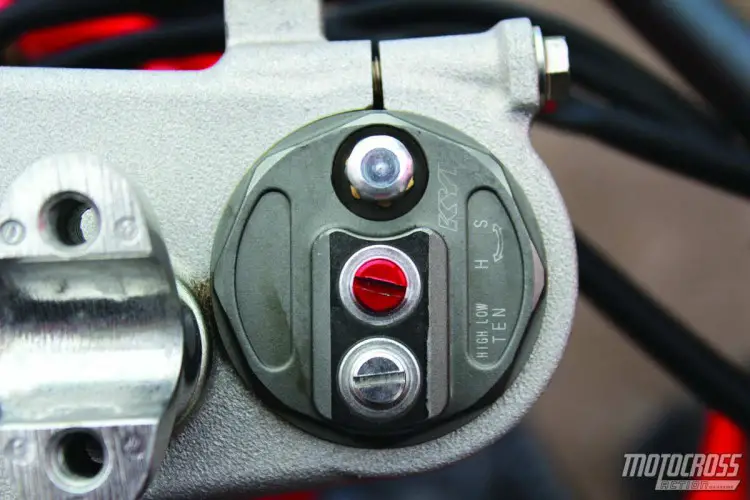
STANDARD SETTINGS
Hi-speed compression: 11 clicks out
Lo-speed compression: 12 clicks out
Hi-speed rebound: 8 clicks out
Lo-speed rebound: 9 clicks out
TECHNICAL NOTES
(1) Closely mimicking the WP 4CS fork (and the old Marzochhi M1 fork), the damping in both legs is close to identical—save for the different location of the free-bleed orifice. It is the free bleed that makes the right side a rebound fork and the left side a compression fork. (2) The PSF-2 uses a coil spring as a balance (negative) spring. (3) There is also a small top-out spring to help on rebound. (4) If you blow a fork seal, air pressure can leak out of that fork leg.
KAYABA SSS COIL SPRING FORK:
THE MOST HIGHLY RATED FORK MADE
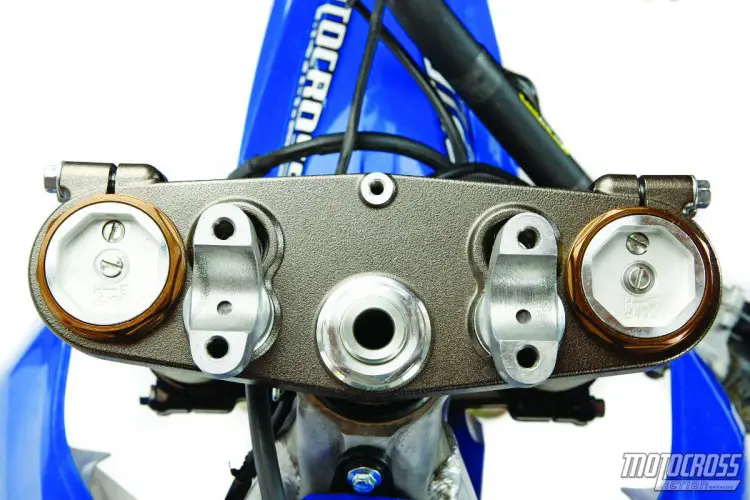
It may seem strange, but the king of fork shootouts is the oldest. Introduced back in 2006. Kayaba’s SSS forks have owned the racetracks of America for the last eight years. The last Yamaha forks before SSS were the 2005 Showaba AOSS forks, and those forks are ancient history, but SSS forks are still with us. Yes, the SSS forks have been updated over the years, but not enough to make anyone consider them to be cutting edge. SSS stands for “Speed Sensitive Damping,” which Yamaha defines as a fork that is “90 percent reliant on the speed of the fork’s movement” and only 10 percent metered by the position of the fork piston during its stroke. To tell the truth, the SSS hyperbole doesn’t mean much, because these are basically old-school forks that get their greatness from solid fluid dynamics and superb testing.
WHAT IT COMES ON
Yamaha YZ125, YZ250, YZ250F and YZ450F
TYPE
Oil-damped, two coil springs, springs in both legs
SPRING
YZ125 spring rate: 0.42 Nm
YZ250 spring rate: 0.43 Nm
YZ250F spring rate: 0.47 Nm
YZ450F spring rate: 0.50 Nm
FORK OIL HEIGHT
Oil height: 335cc
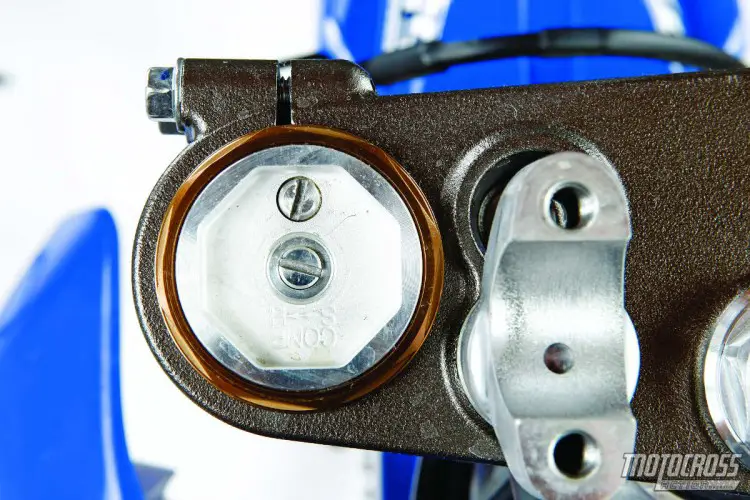
FORK TUBE DIAMETER
48mm
DAMPING CLICKER LOCATION
Compression: On top of both fork caps
Rebound: On bottom of both fork legs
STANDARD SETTINGS
Compression: 8 clicks out
Rebound: 10 clicks out
TECHNICAL NOTES:
(1) The compression clicker is on top of both fork caps, while the rebound clicker is under the fork legs. (2) Over the years, Yamaha has increased the spring rates to keep up with changing track designs and rider speeds. (3) For most smaller riders, the 2014 SSS forks were too firm on the YZ250F. For 2015, Yamaha softened the damping to make the forks more resilient. (4) Weight is a downside of conventional two-spring forks. Air forks can be as much as 3 pounds lighter. (5) If you blow a fork seal, there is no danger of a coil spring going flat.






Comments are closed.